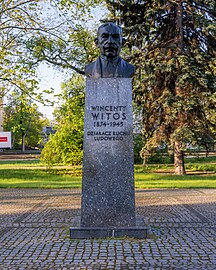
Tenement Freedom Square 1 is an historic house of Bydgoszcz. It is often displayed on postcards as one of the turn of the century iconic building in Bydgoszcz. The architect, Józef Święcicki, is also the builder of the "Pod Orłem" hotel, the oldest hotel in downtown Bydgoszcz. The building is located on the east side of Gdańska Street, on the corner of Plac Wolności.

Casimir the Great Park is the oldest park in Bydgoszcz, Poland, covering an area of 2.24 ha. The park is located in a central part of downtown Bydgoszcz, bordered by Gdańska Street, Konarski Street, Jagiellońska street and Freedom Square. Its area represents a rectangle of 100m by 200m.

The tenement at 86 Gdanska street is a historical habitation building located at 86 Gdanska Street, in Bydgoszcz, Poland.

Jagiellońska Street is a historic street in the centre of Bydgoszcz in Poland.

Jan Kochanowski Park is a green area covering 3,15 ha, located in downtown Bydgoszcz, Poland. It is part of the "Music district in Bydgoszcz" and is named after the Polish renaissance poet, Jan Kochanowski.

Markwarta street is located in the downtown district of Bydgoszcz, Poland. Situated in its path are two green areas and several villas built during the Polish interwar period.

The old water tower is a historic water tower belonging to the municipal water supply network of Bydgoszcz, Poland. Its importance in the local history has been acknowledged in 1986 by a registering on the Kuyavian-Pomeranian Voivodeship Heritage List.

Henryk Dąbrowski Park is a green area covering 2,89 ha, located on the heights of Bydgoszcz, Poland. Aleja Górska is a smaller green walking path that extends to the east of the park.

The Freedom Hill Park is a city green area covering almost 10 ha, located on the heights of Bydgoszcz, Poland.

Szwederowo is a district of the city of Bydgoszcz, Poland, located on its southern territory. Szwederowo population is the second largest of all Bydgoszcz districts.

Maksymiliana Piotrowskiego Street is a street of Bydgoszcz centre, in the vicinity of several city highlights. Many buildings along this path carry historical interest.

Sielanka Street is a small and twisty road, laid in the mid-1910s in downtown Bydgoszcz. It displays a series of villas, each of which is unique in its architectural concept.
Hermann Ernest Georg Dietz, generally called Hermann Dietz, (1861-1944) was a German physician, a member of the Bromberg city council, a senator of the Republic of Poland and a prominent social activist in the first half of the 20th century in Bromberg/Bydgoszcz.

Park Centralny is an urban green area located along the side of the Brda river in Bydgoszcz, Poland. The park covers 6.22 hectares.

The Lubostroń Palace is a neoclassical palace, built in 1795-1800 by Stanisław Zawadzki, a leading architect of the time. Author, among others, of edifices in Warsaw and in the region of the Greater Poland, Zawadzki was commissioned by Count Fryderyk Skórzewski to realize the project on the location of the Piłatowo folwark. The complex has been registered on the Kuyavian-Pomeranian Voivodeship Heritage List.

New Market Square is a city square located in downtown Bydgoszcz, Poland. Dating from the early 19th century, it has been remodelled since its creation.
Makrum is a firm in Bydgoszcz established in 1868, by Hermann Löhnert and manufacturing heavy industrial devices.

Zachem Chemical Plant in Bydgoszcz or Zachem was a firm established in 1948 in Bydgoszcz, Poland, and liquidated in 2014. Zachem was operating in the domain of chemical synthesis. Several of its activities survived in local enterprises in and around Bydgoszcz.

Józef Makowski (1914–1997), was a Polish sculptor and painter whose works are associated with Bydgoszcz.

The Nowofarny cemetery in Bydgoszcz is the one of the largest Roman Catholic cemeteries in this Polish city. One of its oldest area has been registered on the Kuyavian-Pomeranian Voivodeship Heritage List.
































